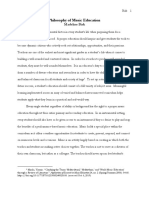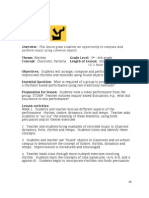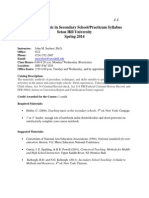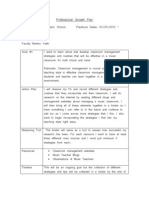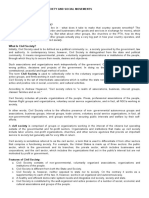How Micro Lessons Affect Music Classes in Chinese Schools
How Micro Lessons Affect Music Classes in Chinese Schools
Uploaded by
Purity AngwenyiCopyright:
How Micro Lessons Affect Music Classes in Chinese Schools
How Micro Lessons Affect Music Classes in Chinese Schools
Uploaded by
Purity AngwenyiOriginal Description:
Original Title
Copyright
Share this document
Did you find this document useful?
Is this content inappropriate?
Copyright:
How Micro Lessons Affect Music Classes in Chinese Schools
How Micro Lessons Affect Music Classes in Chinese Schools
Uploaded by
Purity AngwenyiCopyright:
RP
How Micro Lessons Affect Music Classes in Chinese Schools
Introduction:
Micro-Lesson is a new form of curriculum, which is composed of an organic combination of
teaching resources and network technology (Peng, 2019). The emergence of micro-Lessons is in
line with the fast-paced learning and life of modern society. With the rapid development of
network technology, many new teaching concepts and techniques have emerged in educational
technology. For example, more and more teachers are beginning to devote a lot of time in the
classroom to design various Micro-Lessons. Different from the traditional curriculum model,
Micro-Lessons have clear teaching goals, which can enable students to understand a certain point
of knowledge in a short time (Zhao et al., 2016). Micro-Lesson refers to a new form of curriculum,
which consist of an organic combination of teaching resources and network technology. In other
words, it is a short term course which takes about ten minutes, and uses video as the main carrier
of information. Micro-Lessons are different from traditional teaching in that its content is very
limited and it focuses on solving a one problem (Zhao et al., 2016, cited in Li, 2013). For example,
more and more teachers are beginning to devote a lot of time in the classroom to design various
Micro-Lessons. Lang Lang, as an internationally renowned pianist and music educator, he opened
the "Lang Lang Piano Class" in China (Xie, 2019). On the Internet, each micro-course will be
recorded for 1-6 minutes. Currently, "Langlang Piano Lesson" has recorded more than 50 lessons.
All the course content is continuously updated, covering the most basic scale and harmony
exercises, which can allow the audience to practice musical difficulty to a certain extent. Among
the micro-courses recorded by Lang Lang, to a great extent, it provides a good learning platform
for all music learners. Let everyone have access to the famous teacher's classroom and the micro-
courses on the online platform are even open and free so that everyone can watch the music
lessons of famous pianists. Arguably, teachers and students in China have adopted Lang Lang
piano class (Xie, 2019). According to them, Lang Lang piano classes enhance their teaching and
learning experience since it displays videos that are easy to follow (Xie, 2019). Therefore, this
research will determine the impact of micro-classes by using Chinese teachers as example. Ideally,
the research will begin by examining the basic characteristics of micro-class teaching through
mixed research methods. Besides, the paper will also focus on the application value of micro-
course teaching. Thereafter, the study will focus on the problems and solutions in the process of
micro-class teaching. Notably, this research will be conducted at a university in Guangzhou, China
involving teachers between the ages of 25-45 years selected randomly. However, questionnaires
will then be used to collect data from the participants. Finally, a triangulation method will be used
to combine the result obtained in the questionnaires and interviews.
For music teachers, the transition from the traditional teaching model to the new teaching model is
a very difficult challenge. First of all, not all teachers can master the teaching mode of micro-
classes. Secondly, there are still many teachers who do not understand the development and
technology of micro-classes, which will cause teaching problems when used in the classroom
(Lim et al., 2007). On the other hand, more and more teachers have joined the development of
micro-classes. They are embodied in multi-dimensional activities with students. Micro-classes can
help students understand what they have learned faster through multimedia means (Zhao et al.,
Sheffield.ac.uk/international-college – Effective from September 2015 1
2016). On the one hand, the purpose of this research is to understand whether teachers use micro-
classes in a good direction. On the other hand, it can also help educators improve the teaching
mode by collecting feedback from students (Wang et al., 2020). Therefore, since the traditional
curriculum models did not have clear teaching goals, this research will explore on the impact of
micro-lesson in enabling students to understand certain point of knowledge in a short time.
Research questions:
1. What are the practical teaching problems of micro-classes in Chinese music classrooms?
2. Will micro-classes replace traditional teaching methods in the future education model?
Objectives:
1. To investigate the impact of micro-lessons in teaching and learning.
2. To identify the characteristics of micro-lesson.
3. To determine the problems and solutions of micro-lesson.
4. To identify the study population and design questionnaires and interviews based on the
study topic to collect data.
5. To provide recommendations to the teachers of music course on the appropriate ways to
utilize Lang Lang piano class to enhance teaching and learning.
The rest of this proposal will contain two parts: Literature review and methodology.
Literature Review
Micro-Lesson is a new form of curriculum, which is composed of an organic combination of
teaching resources and network technology (Peng. 2019). Notably, the emergence of micro-
Lessons is in line with the fast-paced learning and life of modern society. Ideally, with the rapid
development of network technology, many new teaching concepts and techniques have emerged in
educational technology. Notably, teaching micro-courses has been a challenge for many teachers
and learners due to lack of sufficient materials. However, today more and more teachers are
beginning to devote a lot of time using online materials to design various Micro-Lessons. Notably,
Lang Lang, as an internationally renowned pianist and music educator, he opened the "Lang Lang
Piano Class" in China (Xie, 2019). Therefore, on the Internet, each micro-course will be recorded
for 1-6 minutes. Currently, "Langlang Piano Lesson" has recorded more than 50 lessons.
However, all the course content is continuously updated, covering the most basic scale and
harmony exercises, which can allow the audience to practice musical difficulty to a certain extent.
Arguably, among the micro-courses recorded by Lang Lang, to a great extent, it provides a good
learning platform for all music learners. Moreover, it allow everyone to have access to the famous
Sheffield.ac.uk/international-college – Effective from September 2015 2
teacher's micro-courses on the online platform, which are even open and free so that everyone can
watch the music lessons of famous pianists.
In addition, there are two well-known micro-course applications on the network platform, namely
"Olive Classical Music" and "Music Planet"(Xie, 2019). Ideally, these two applications can
provide two different types of music micro-courses for music students. Notably, they are the first
stage piano teaching method in music education by Fang Baili of Shanghai Conservatory of
Music. However, another type is the piano teaching method of Shanghai Conservatory of Music
for singing and playing courses, which aims to improve the music level of teachers and students.
Arguably, both types of courses are currently being continuously updated. Ideally, each lesson
lasts between 15-30 minutes, allowing learners to master a certain music knowledge point in a
short time. Arguably, different from the traditional curriculum model, Micro-Lessons have clear
teaching goals, which can enable students to understand a certain point of knowledge in a short
time (Zhao et al., 2016). According to Zhao et al. (2016), "Micro-Lessons" refers to a short-term
course of less than ten minutes with video as the main information carrier. Consequently, micro-
Lessons are different from traditional teaching in that its content is very limited and it focuses on
solving a one problem (Zhao et al., 2016, cited in Li, 2013).
Therefore, in this literature review, this research will focus on the characteristics and teaching
advantages of the micro-class teaching method and its impact on the Chinese music classroom.
Ideally, the first part will focus on analyzing the characteristics and advantages of the micro-
course teaching method. However, the second part is through the application value analysis of
micro-class teaching and its influence on traditional Chinese music classroom. Finally, the last
section will analyze the significance of micro-class data to Chinese music classrooms.
The basic characteristics of micro-class teaching
Notably, among the collected literature, most of the attention is that micro-lessons has been a
challenge due to poor technology. However, due to advancement in technology, teaching and
learning the micro courses has been a walk in the park. Arguably, it can help teachers adapt to
information and modern communication technology, and use the Internet to expand teaching
effects. Therefore, the development and improvement of micro-lessons technology has become a
research focus. However, as a product of the new media, micro-classes first appeared in 2006.
Arguably, an Indian-American named Salman Khan founded a non-profit educational organization
—The Khan Academy which provides services to people all over the world (Xie, 2019). Notably,
it provides free high-quality learning services.
Sheffield.ac.uk/international-college – Effective from September 2015 3
Notably, the traditional methods of teaching and learning did not allow transfer and sharing of
information. However, the biggest feature of the micro-class is the use of recording and touch
panels to record the course content and upload it to the online platform. However, in other
countries, the definition of micro-course refers to the use of network technology to realize online
learning or mobile learning (Feng, J., & Zhao, 2017). Therefore, students are no longer restricted
by time and space in the learning process. However, short video teaching courses have clear
teaching content and teaching goals. Moreover, short teaching time and simplification of teaching
links are the most prominent features of micro-classes (Xie, 2019). Notably, the recording time of
micro-classes is generally controlled at about 10 minutes. Nonetheless, it is hoped that through
concentrated teaching content, students can absorb knowledge more effectively in a short time
(Peng, 2019). However, in the entire micro-class classroom, it solves the limitations of time and
space. Therefore, the many advantages of micro-classes have become an important part of
education.
Arguably, the traditional curriculum was inflexible and was not rich in content. However, the form
of micro-classes is flexible, rich in content, and focused (Zhao et al., 2016). However, the most
important thing is that the attractiveness to students is unmatched by traditional teaching.
Arguably, micro-classes provide students with a channel for independent learning, which allows
students to do independent learning and provides a wealth of choices in teaching resources (Zhao
et al., 2016). Therefore, this shows that traditional music classrooms can no longer satisfy modern
teaching. Moreover, with the rapid development of scientific and technological equipment,
teaching methods should be carried out in multiple ways instead of relying on a single traditional
classroom model.
The application value of micro-course teaching
Notably, mobile learning was not achievable with the traditional curriculum. However, for fast-
paced learning and life needs, the most significant application value of micro-classes is that it
allows everyone to realize mobile learning (Hou et al., 2016). However, there are also TED talks
that have the same concept as micro-classes. Arguably, the goal of TED talks is to let people listen
to a great speech with a cup of coffee. However, the goal of micro-classes is that the unrestricted
learning mode greatly satisfies people's curiosity. Secondly, micro-classes can highlight the
subjective status of students in the learning process to the greatest extent (Hou et al., 2016).
Nonetheless, in the traditional music classroom, the teacher is dominant. Furthermore, the teacher
is the main body to develop the teaching content and music training, and the students are in a
passive position to listen to the lecture (Xie,2019).
Sheffield.ac.uk/international-college – Effective from September 2015 4
Arguably, the initiative of students is difficult to be effectively stimulated in the traditional music
classroom. However, the emergence of micro-classes has reversed this situation that is not
conducive to student learning. Notably, as a condensed course, micro-classes can take care of
some students' need for short breaks all the time. Furthermore, the fragmentation of long-term
learning content can ensure student participation and reduce the chance of student distraction
(Ruixi, 2019). Moreover, for some newly mastered knowledge points, Ruixi (2019) found out that
students can also study and review repeatedly, and the micro-class can ensure the students'
learning efficiency to the greatest extent. Therefore, this shows that the teaching methods of
micro-classes will be more personalized. However, Ruixi (2019) did not reveal the actual
application of micro-classes in China. Consequently, among the searched documents, most of the
researches showed that the focus is on the design of music micro-classes, and there is a lack of
teaching thinking and further exploration of actual classrooms.
Problems and Solutions in the Process of Micro-Class Teaching
Arguably, the development history of micro-classes in China is obviously very short (Peng, 2019).
Therefore, there is a big gap between micro-course learning and traditional teaching mode (Xiuli.,
2018). Micro-class is a teaching method based on the network. Arguably, only when it is fully
integrated with the network can the micro-class play its greatest role. Although the teaching of
micro-classes pays more attention to students' independent learning, the learning process of micro-
classes is a state without supervision, which tests students' self-discipline in learning.
However, for some controllable mature students, micro-classes have a high degree of flexibility.
However, for younger students, the effect of micro-classes on its influence is obviously relatively
weak (Wang et al., 2020). Notably, as a teacher in charge of teaching, you may still need to guide
children. For example, make some interesting videos to attract students' attention and give play to
the unique teaching effect of music micro-classes for children. Secondly, as a kind of teaching
method for freshmen, the short "growth time" of micro-class also brings about the problem of low
level of micro-class teaching.
Notably, in today's Chinese society, a variety of new media applications have appeared, such as
VIP musical instrument sparring applications, etc. (Xie, 2019). Arguably, these applications may
attract the attention of students and parents through cheap fees. However, the teacher's teaching
level cannot guarantee the quality. For instance in the traditional setting, the students had a
relatively poor experience on music learning based on micro-classes. However, to improve the
teaching level of teachers' music micro-classes, we can carry out music micro-class training or
conduct music micro-class review among teachers (Chen, 2019). For instance, technicians
Sheffield.ac.uk/international-college – Effective from September 2015 5
improve the micro-class recording technology to make it easier for teachers to control in the
classroom, which can improve teachers' acceptance of micro-class technology (Abraham et al.
2020). In addition, the researchers of micro-class technology track the experience of teachers.
Furthermore, teachers can also conduct follow-up experience surveys of students after learning. In
this way, the teaching methods and strategies of music micro-classes can be adjusted in time
(Napoles, 2008). On the one hand, tracking the teacher's teaching after class can improve the
future teaching efficiency based on investigation and research. Besides, through literature
retrieval, there are relatively few materials about the teaching experience after class. Therefore,
there is still a lot of research value and space in the study of Chinese music classrooms in micro-
classes.
Conclusion
In summary, although micro-classes are a new type of teaching method in traditional music
classrooms, they have significant significance and effect on the innovation and reform of Chinese
music teaching. However, with the development of technology and multimedia technology, the
application of micro-courses in the future will definitely be deepened. Notably, the development
time of micro-classes in China is relatively short, and at the same time, there are still many
problems in the current teaching situation due to the lack of popularization. However, we cannot
deny the good teaching effect brought by the micro-class music classroom. Therefore, since the
traditional curriculum did not allow teachers and learners to share information using digital
sources, I think the education department and technical department should accelerate the research
and exploration of micro-classes, actively develop the combination of micro-class education and
traditional education, infiltrate micro-class teaching into traditional teaching classrooms, and
guide students to actively and autonomously start music learning. However, with the help of the
diversified teaching mode of micro-classes, we can provide targeted music micro-class education
to students. Arguably, there is a big gap between the learning mode of micro-classes and the
traditional teaching mode. Besides, micro-class is a teaching method based on the Internet.
Therefore this shows that it is more difficult for teachers to guide and supervise students'
autonomous learning by means of micro-classes. However, especially for students of different
ages, micro-classes have different effects. For example, micro-classes are more suitable for some
older students. However, for some younger students, micro-classes may not help teachers achieve
the expected teaching results. Therefore, this research hopes to improve the traditional Chinese
music classroom by investigating the teaching situation of teachers. Finally, it is hoped that
through research, the teaching methods and strategies of future music micro-classes can be
Sheffield.ac.uk/international-college – Effective from September 2015 6
adjusted. However, the nature of this research proposal is explained in details in the methodology
section.
Methodology
Introduction
The purpose of this research is to take Chinese college teachers as an example to study the impact
of micro-classes on Chinese music classrooms. In addition, the question to be answered in this
study is to analyze the feasibility, aesthetics, and procedural nature of the use of micro-classes in
Chinese music teaching. Because these factors have a greater impact on the quality of music
teaching, this research hopes to study the practical problems of micro-course teaching through
further analysis of the teaching characteristics and application value of micro-courses. In the
actual teaching process of teachers, some practical solutions and thoughts of music micro-class
teaching are proposed. This research hopes to further analyze the teaching characteristics and
application value of micro-classes through mixed research methods, and to study the practical
problems of micro-class teaching. In the actual teaching process of teachers, some practical
solutions and thoughts of music micro-class teaching are proposed. The ultimate purpose of this
research is to help and promote teachers to use more efficient teaching methods to complete
classroom teaching tasks by analyzing the feasibility of using micro-classes in the process of
Chinese music teaching, the existing problems and how to apply micro-classes.
Research design
In this research, I want to use a mixed method to analyze my research (Baškarada, 2014). Mixed
methods can further analyze the quantitative and qualitative research issues in the research (De
Kock, 2015). Make my research report get more accurate analysis data. Therefore, this study will
use questionnaires to examine the use of micro-classes by relevant teachers. In the process of
collecting information, some teachers will be selected for one-on-one interviews. I hope that
through interviews, my data can be more targeted and accurate. Ideally, the questionnaires and
interviews will be used to gather information about the challenges and benefits that teachers and
students have while learning the micro-courses.
Setting
This research will be conducted at a university in Guangzhou, China. Compared with other
Chinese cities, Guangzhou has the newest educational hardware and the convenience of location
Sheffield.ac.uk/international-college – Effective from September 2015 7
that its data will be more representative. By conducting interviews and questionnaire surveys with
teachers in Guangzhou universities, we can obtain detailed sample data and make my investigation
and research more accurate. Researchers will conduct a questionnaire survey of teachers in
universities in Guangzhou, from which 20 people will be selected for research.
Participants
Participants in this study will choose teachers between 25-45 years old because they are above the
age of the majority, and can respond to questions with their consent. The main purpose is to
explore the influence of micro-classes on music classrooms, and analyze the degree of influence of
micro-classes on Chinese music teaching through surveys of teachers. In this research project, I
will take a questionnaire survey to randomly select 5 music teachers in four grades, and distribute
20 teacher questionnaires to the 20 randomly selected teachers to start the survey. Hope to learn
about the teaching situation of different grades among teachers of different grades. Before
randomly selecting teachers, they will ask their opinions in advance whether they agree to
participate in the research survey. In the process of teachers filling out the questionnaire, in order
to protect the privacy of teachers, an anonymous survey will be adopted.
Materials
First, this research will create a questionnaire survey form in advance, and then distribute it to 20
teachers to fill out. In addition, the researchers will conduct interviews with 20 teachers. One-to-
one interviews will be conducted in school classrooms to ensure the privacy of survey users.
During the interview, we will photograph and record the entire interview process, and we will
obtain the consent and permission of the survey user before the interview begins. Participants will
not be forced to answer overly sensitive or extreme questions. We will ensure the privacy of
participants and respect their opinions.
Data collection/procedure
First, the researchers distributed a questionnaire containing 14 questions to the teachers of the
university. A questionnaire survey takes about 3-5 minutes to complete. Then conduct interviews
with 20 teachers one by one. It is necessary to obtain the teacher’s consent and ensure that the
teacher’s privacy is protected before the interview. In the one-on-one interview session, we hope
to arrange it between 15-20 minutes. At the same time, researchers need to record and film the
entire conversation. In addition, 100 students in the school will be randomly selected and
Sheffield.ac.uk/international-college – Effective from September 2015 8
interviewed anonymously. In the process of collecting student data, researchers need about 14
days to collect and analyze the data.
Data analysis
First of all, the researcher's purpose of collecting data from teachers is to test and understand the
teaching methods supported by teachers and micro-classes. First, the researchers will collect
teachers’ teaching status through anonymous questionnaires. Second, analyze the semi-structured
interviews and recordings again. Finally, the researchers will use the triangulation method to
combine the results of the anonymous questionnaire and the interview to reach the final
conclusion.
Limitations
Because quantitative analysis requires more samples to obtain more accurate data, only 20
teachers participated in this research, and the final research results may not be accurate and
relevant. In addition, since qualitative research belongs to the category of interpretivism (Packard.,
2017), this research cannot avoid the possibility of bias.
Potential Significance
The advantage of this research project is that it will have special significance for the teaching
innovation and reform of college teachers by investigating the impact of micro-classes on Chinese
music classrooms. Notably, the traditional curriculum did not improve teacher and students
teaching and learning experience. However, through the investigation, we will find more problems
in the current situation of micro-class teaching. Finally, the development time of micro-classes in
China is still relatively short, and it may not be popular enough. However, the effect of micro-
class music teaching is relatively significant (Peng, 2019). The ultimate goal of this research is to
summarize and summarize the current development of Chinese music micro-class teaching, and
then propose targeted strategies for Chinese music micro-class teaching to further improve the
effect and quality of micro-class in Chinese music classrooms.
Anticipating the challenge
Since one-to-one interviews will be arranged during the research process, some interviewees will
have tension problems. Therefore, if this situation is encountered during the interview, the
Sheffield.ac.uk/international-college – Effective from September 2015 9
researcher will arrange for the interviewee to have a video conference. In addition, in the case of
insufficient research time and samples, the final results of this research may be inadequate. In the
literature, there is still a lack of follow-up of micro-classes after class. I think there can be more
research price and space in the link of the teaching situation of the micro-class. It is of great
significance to the future music teaching in China.
Reference List:
Abraham, F.-G., Rubén, V.-S., Rocío, C.-F., & Aurelio, C.-F. (2020). Use of arduino
microcontroller in education: Creation of “the musical stairs”. Proceedings, 54(1), 6.
https://doi.org/10.3390/proceedings2020054006
Baškarada, S. (2014). Qualitative case study guidelines. The Qualitative Report, 19(40), 1–18.
https://doi.org/10.46743/2160-3715/2014.1008
Chen, Y. (2019). School Music Education and the Inheritance of National Music Culture.
https://webofproceedings.org/proceedings_series/ESSP/ICETEM%202019/ICETEM187.pdf
De Kock, M. (2015, June). Ontology and a mixed methods epistemology in applied research. In
Proceedings of the European Conference on e-Learning (pp. 170-176).
Feng, J., & Zhao, S. (2017, April). Research on Development Countermeasures of the Micro
Courses Construction in Colleges and Universities. In 7th International Conference on Education,
Management, Information and Mechanical Engineering (EMIM 2017). Atlantis Press.
https://www.atlantis-press.com/proceedings/emim-17/25879581
Hou, T., Gou, X., & Gao, Y. (2016). Preliminary application of micro-course in distance
education. International Journal of Information and Education Technology, 6(2), 132.
https://www.semanticscholar.org/paper/Preliminary-Application-of-Micro-Course-in-Distance-
Hou-Gou/8732744891e2da42bc1c39ff6dc16ae28cc4873b?p2df
Sheffield.ac.uk/international-college – Effective from September 2015 10
Napoles, J. (2008). Relationships among instructor, peer, and self-evaluations of undergraduate
music education majors’ micro-teaching experiences. Journal of Research in Music
Education, 56(1), 82–91. https://doi.org/10.1177/0022429408323071
Peng, Yan. (2019). Application of Micro-lecture in Computer Teaching. IOP Conference Series.
Earth and Environmental Science, 234(1), 12053. IOP Publishing. https://doi.org/10.1088/1755-
1315/234/1/012053
Punch, S., Harden, J., Marsh, I., & Keating, M. (2013). Sociology [electronic resource]: Making
sense of society (Fifth edition.). Pearson. http://www.vlebooks.com/vleweb/product/openreader?
id=USheffield&isbn=9781408269565
Ruixi, G. (2019). Analysis of the Status Quo of Basic Music Education Reform in Xi'an under the
Vision of" Internet+ Education" and Research on Basic Countermeasures.
https://www.webofproceedings.org/proceedings_series/ESSP/ICETEM%202019/ICETEM189.pdf
Xie, H. (2019). Internet Thinking in College Music Education Professional Piano Teaching.
Frontiers in Educational Research, 2(12).
https://francis-press.com/papers/1110
Xie, S. (2019). Research on the Innovation Path of Piano Teaching in Colleges and Universities in
the" Micro-era.
https://webofproceedings.org/proceedings_series/ESSP/IWEDSS%202019/IWEDSS19183.pdf
Xiuli, W. (2018). Research on the Reform Methods of College Music Teaching under the New
Media.
https://pdfs.semanticscholar.org/45f3/edff8a95d160dc45bd7a908abea7df0e9eab.pdf
Wang, Kai, Zhu, Chang, & Tondeur, Jo. (2020). Using micro-lectures in small private online
courses: what do we learn from students' behavioural intentions? Technology, Pedagogy and
Education. https://doi.org/10.1080/1475939X.2020.1832565
Sheffield.ac.uk/international-college – Effective from September 2015 11
Zhao, Guodong, Wang, Bingyi, Liu, Jinglu, & Wang, Jingxing. (2016). Microlessons in Chinese
Universities: Concepts, Technology, and Case Analyses. Blended Learning: Aligning Theory with
Practices, 9757, 73–84. Cham: Springer International Publishing. https://doi.org/10.1007/978-3-
319-41165-1_7
Sheffield.ac.uk/international-college – Effective from September 2015 12
You might also like
- Middle Years Music Education - Kodály AustraliaNo ratings yetMiddle Years Music Education - Kodály Australia6 pages
- Music DLP General Music 7th Grade Lesson PlanNo ratings yetMusic DLP General Music 7th Grade Lesson Plan17 pages
- Teaching and Learning Music CompositionNo ratings yetTeaching and Learning Music Composition21 pages
- Elementary General Music Textbook EvaluationNo ratings yetElementary General Music Textbook Evaluation5 pages
- Application of Multimedia Technology in Music Teaching in Junior High School100% (1)Application of Multimedia Technology in Music Teaching in Junior High School6 pages
- A Study of The Kodaly Approach To Music Teaching PDFNo ratings yetA Study of The Kodaly Approach To Music Teaching PDF190 pages
- Lesson Plan Examples at Level 4 and Level 6: Rockschool Licentiate in Music Teaching (LRSL) Level 6No ratings yetLesson Plan Examples at Level 4 and Level 6: Rockschool Licentiate in Music Teaching (LRSL) Level 67 pages
- Integrating Technology Into The 2nd Grade Music Curriculum 1No ratings yetIntegrating Technology Into The 2nd Grade Music Curriculum 149 pages
- K6 Creatart Uw MusicCREATE ART WITH MUSICNo ratings yetK6 Creatart Uw MusicCREATE ART WITH MUSIC44 pages
- Music DLP General Music 2nd Grade Lesson PlanNo ratings yetMusic DLP General Music 2nd Grade Lesson Plan12 pages
- Smu 331 Music in Secondary School Practicum Syllab 7No ratings yetSmu 331 Music in Secondary School Practicum Syllab 718 pages
- Whitcomb 2013 - Teachingimprovisationinelementarygeneralmusicfacin Retrieved 2015-09-28No ratings yetWhitcomb 2013 - Teachingimprovisationinelementarygeneralmusicfacin Retrieved 2015-09-288 pages
- 2nd Grade Black History Month Unit CompressedNo ratings yet2nd Grade Black History Month Unit Compressed73 pages
- Musical Identities - The Development of Musical Preferences in Childhood and Adolescence100% (2)Musical Identities - The Development of Musical Preferences in Childhood and Adolescence40 pages
- Intro To Voice Unit of Lessons - Mari BellNo ratings yetIntro To Voice Unit of Lessons - Mari Bell11 pages
- Music DLP General Music 6th Grade Lesson PlanNo ratings yetMusic DLP General Music 6th Grade Lesson Plan28 pages
- IB Music Revision Guide, 3rd Edition: Everything you need to prepare for the Music Listening Examination (Standard and Higher Level 2019–2021)From EverandIB Music Revision Guide, 3rd Edition: Everything you need to prepare for the Music Listening Examination (Standard and Higher Level 2019–2021)2.5/5 (3)
- BECED2A - Domalanta, Austin Josh - Before and After Venn DiagramNo ratings yetBECED2A - Domalanta, Austin Josh - Before and After Venn Diagram2 pages
- Arts of Neoclassical and Romantic Period: Different Media TechniquesNo ratings yetArts of Neoclassical and Romantic Period: Different Media Techniques9 pages
- Understanding Self-Injury: A Person-Centered Approach Stephen P. Lewis download pdf100% (4)Understanding Self-Injury: A Person-Centered Approach Stephen P. Lewis download pdf66 pages
- Peter Irons and Melvin Lewis v. Federal Bureau of Investigation and Department of Justice, 811 F.2d 681, 1st Cir. (1987)No ratings yetPeter Irons and Melvin Lewis v. Federal Bureau of Investigation and Department of Justice, 811 F.2d 681, 1st Cir. (1987)13 pages
- Download full The Last of the Mohicans Webster s German Thesaurus Edition James Fenimore Cooper ebook all chapters100% (4)Download full The Last of the Mohicans Webster s German Thesaurus Edition James Fenimore Cooper ebook all chapters81 pages
- MARK 2063 - Media Analytics & Social MediaNo ratings yetMARK 2063 - Media Analytics & Social Media58 pages
- The Cheap Retreat Workbook by Catharine BramkampNo ratings yetThe Cheap Retreat Workbook by Catharine Bramkamp31 pages
- Jesus Unveiled Revelation: Heaven, Happy Home AboveNo ratings yetJesus Unveiled Revelation: Heaven, Happy Home Above2 pages
- Download Complete Into the Wardrobe C S Lewis and the Narnia Chronicles 1st Edition David C. Downing PDF for All Chapters100% (18)Download Complete Into the Wardrobe C S Lewis and the Narnia Chronicles 1st Edition David C. Downing PDF for All Chapters60 pages
- Week 17 - Civil Society and Social MovementsNo ratings yetWeek 17 - Civil Society and Social Movements7 pages
- 1st Manipal Ranka National Moot Court Participation Memorial50% (4)1st Manipal Ranka National Moot Court Participation Memorial23 pages
- John Donne: Poems Summary and Analysis of "The Sunne Rising"No ratings yetJohn Donne: Poems Summary and Analysis of "The Sunne Rising"19 pages
- Application of Multimedia Technology in Music Teaching in Junior High SchoolApplication of Multimedia Technology in Music Teaching in Junior High School
- A Study of The Kodaly Approach To Music Teaching PDFA Study of The Kodaly Approach To Music Teaching PDF
- Lesson Plan Examples at Level 4 and Level 6: Rockschool Licentiate in Music Teaching (LRSL) Level 6Lesson Plan Examples at Level 4 and Level 6: Rockschool Licentiate in Music Teaching (LRSL) Level 6
- Integrating Technology Into The 2nd Grade Music Curriculum 1Integrating Technology Into The 2nd Grade Music Curriculum 1
- Smu 331 Music in Secondary School Practicum Syllab 7Smu 331 Music in Secondary School Practicum Syllab 7
- Whitcomb 2013 - Teachingimprovisationinelementarygeneralmusicfacin Retrieved 2015-09-28Whitcomb 2013 - Teachingimprovisationinelementarygeneralmusicfacin Retrieved 2015-09-28
- Musical Identities - The Development of Musical Preferences in Childhood and AdolescenceMusical Identities - The Development of Musical Preferences in Childhood and Adolescence
- IB Music Revision Guide, 3rd Edition: Everything you need to prepare for the Music Listening Examination (Standard and Higher Level 2019–2021)From EverandIB Music Revision Guide, 3rd Edition: Everything you need to prepare for the Music Listening Examination (Standard and Higher Level 2019–2021)
- IN PURSUIT OF MUSICAL EXCELLENCE: Essays On MusicalityFrom EverandIN PURSUIT OF MUSICAL EXCELLENCE: Essays On Musicality
- BECED2A - Domalanta, Austin Josh - Before and After Venn DiagramBECED2A - Domalanta, Austin Josh - Before and After Venn Diagram
- Arts of Neoclassical and Romantic Period: Different Media TechniquesArts of Neoclassical and Romantic Period: Different Media Techniques
- Understanding Self-Injury: A Person-Centered Approach Stephen P. Lewis download pdfUnderstanding Self-Injury: A Person-Centered Approach Stephen P. Lewis download pdf
- Peter Irons and Melvin Lewis v. Federal Bureau of Investigation and Department of Justice, 811 F.2d 681, 1st Cir. (1987)Peter Irons and Melvin Lewis v. Federal Bureau of Investigation and Department of Justice, 811 F.2d 681, 1st Cir. (1987)
- Download full The Last of the Mohicans Webster s German Thesaurus Edition James Fenimore Cooper ebook all chaptersDownload full The Last of the Mohicans Webster s German Thesaurus Edition James Fenimore Cooper ebook all chapters
- Jesus Unveiled Revelation: Heaven, Happy Home AboveJesus Unveiled Revelation: Heaven, Happy Home Above
- Download Complete Into the Wardrobe C S Lewis and the Narnia Chronicles 1st Edition David C. Downing PDF for All ChaptersDownload Complete Into the Wardrobe C S Lewis and the Narnia Chronicles 1st Edition David C. Downing PDF for All Chapters
- 1st Manipal Ranka National Moot Court Participation Memorial1st Manipal Ranka National Moot Court Participation Memorial
- John Donne: Poems Summary and Analysis of "The Sunne Rising"John Donne: Poems Summary and Analysis of "The Sunne Rising"








